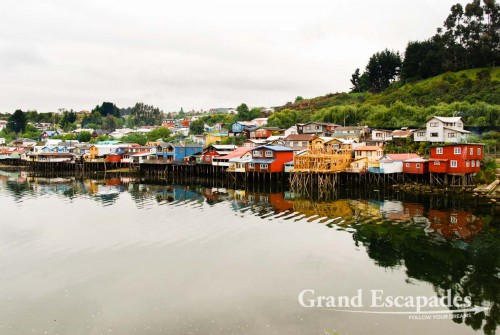
The “Palafitos” are the trademark of Chiloe. Those wooden houses were built in the beginning of the 20th century. More than 1.000 of them could be found on the shores of Chiloe. Now only 120 remain…
Another crazy trip! The first bus ride took me from El Bolsón to San Carlos de Bariloche, in the Argentinean Lake District, 2 hours. One hour later, I took another bus from Bariloche to Puerto Montt in Chile, a 7 hour ride and almost immediately after I took the last bus to Castro, the main city of on the island of Chiloe, arriving there at 11:00 pm, after 13 hours on a bus and 15 hours traveling, exhausted and near starvation, since I had nothing all day to eat but two energy bars. There, it was foggy, rainy and bitterly cold, a quite depressing first impression of Chile!
I checked in the very pleasant Hostal Cordillera, with simple but very cheap rooms with shared bathroom. The atmosphere was very cozy, a living room with a chimney that was lit every evening, Internet, kitchen-use and a very friendly family who do everything to make you feel home.
I immediately found the restaurant La Piazza near the Plaza de Armas, where I ate the three nights I was in Castro: a warm place where you can get fantastic grilled steaks and good Chilean wines. So the first night I went for the baby portion: 250 grams. The second I decided to be more serious and took the “normal” portion: 400 grams. Friday, the thirds night, there was an “All you can eat” barbecue … Heidi was not there so I just could enjoy it intensively without anyone rolling eyes and making unwelcome comments. One of the unforgettable experiences there was the cook taking care of the barbecue, called “El Macho” by the staff. In his mid-fifties, with a great sense of perfection and impeccable service, he led the operations with an iron fist but a nice touch of humor, truly enjoyable. I cannot recommend this place enough, even though it is a little pricy!
Chiloe itself is surprising … Different! There is definitely no highlight to see or do. But the atmosphere has something special. The weather is the first thing that strikes you: if there is no fog, it rains, or the other way around: the sun is rarely seen. It is very green, with low trees or high bushes, and in spring full of yellow Retima bushes. Here and there you see fields with cattle grazing around. Almost all houses are made of wood with tin roofs and are painted in bright colors.
The Chilote, the 155.000 people living on the 40 islands constituting the Archipelago of Chiloe, are of Indigenous and Spaniards origins and have lived a very isolated life. They seem very different from the mainlanders in many ways, physically, but also in their traditions and history. Faces often show the marks of a hard life. During discussions with a few people I met, I learned that the vast majority of them hardly ever leaves the Archipelago: a trip to Puerto Montt, the bigger city nearest to Chiloe on the mainland, is considered by many as a long trip that will only be seldom undertaken! And Santiago seems like a different universe …
On my first day I visited Castro and its wooden churches, especially the fascinating Iglesia de San Francisco, a small cathedral completely made of wood! I also went to see the “Palafitos”, the trademark of Chiloe. Those wooden houses were built in the beginning of the 20th century. There used to be 1.000 of them on the shores of Chiloe, now only 120 remain. In the afternoon, I went to Achao to visit the oldest church on Chiloe, built in 1660, a cathedral-like building completely made of wood.
The second day I took a tour to Chiloe National Park, where you can find primary rainforest, moss-covered trees and foggy beaches … Nothing really spectacular! The most pleasant aspect of the visit was that I joined a group of travelers coming from Chonchi, another village in Chiloe: several Germans and Italians on a “Round The World Trip” and a French guy in his mid-fifties traveling around the world on a horse! A lot of different characters, a really pleasant and interesting crowd, I spent a great day with them!
On Saturday, I took the bus back to the mainland to meet Heidi at Puerto Varas, 30 kilometers north from Puerto Montt, a city that wants to be the Bariloche of the Chilean Lake District.

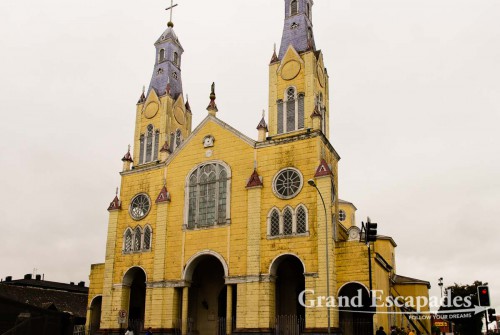

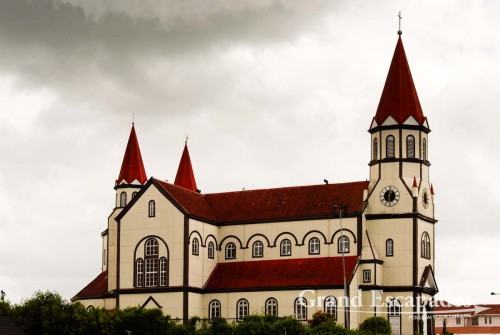
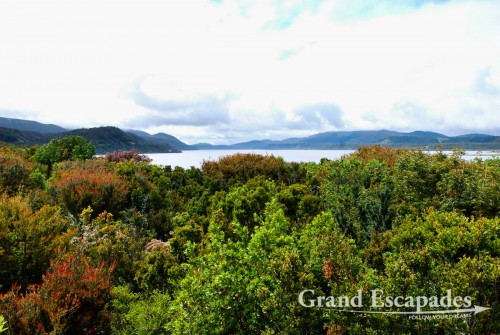
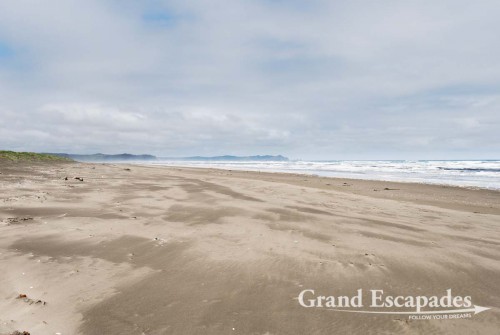
No comments yet.